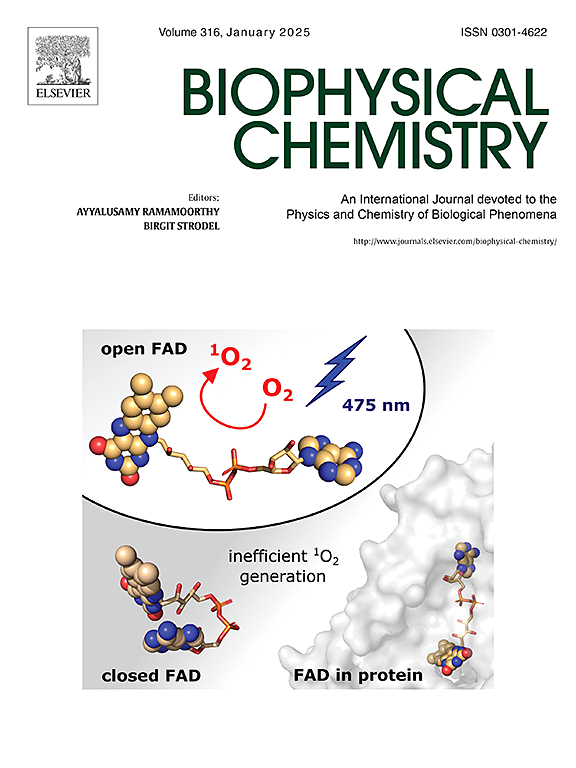Substitutions at rheostat position 52 of LacI have long-range effects on the LacI conformational landscape
IF 2.2
3区 生物学
Q2 BIOCHEMISTRY & MOLECULAR BIOLOGY
引用次数: 0
Abstract
In proteins, amino acid changes at “rheostat” positions exhibit functional changes that vary with the substitution chosen: some substitutions enhance function, some are like wild-type, some are partially detrimental, while others abolish function. One way that substitutions might exert their complex effects is by altering protein conformational landscapes. To test this, we studied five substitutions of V52 in E. coli LacI, an experimentally-known rheostat position. For each variant, we mapped the accessible conformational landscapes by performing molecular dynamics simulations at ambient conditions and under three perturbations: increased pressure, binding to allosteric ligand “ONPF”, and ONPF plus pressure. The simulated DNA binding domain landscapes were compared to published experimentally-measured parameters, and the results suggest that complex combinations of dynamic parameters and/or additional simulations in the presence of DNA are needed to predict DNA binding specificity. For the variants regulatory domains all landscapes displayed boundaries similar to wild-type, but changes within the boundaries were unique. Of these, V52A/ONPF was striking: The regulatory domains for ONPF-bound, wild-type LacI are in an “Open” conformation and, experimentally, ONPF enhances DNA binding. Four variants responded to ONPF like wild-type, but ONPF binding to V52A shifted these domains to a “Closed” conformation that is associated with diminished DNA binding for wild-type LacI. This finding predicted that ONPF's allosteric regulation of V52A would change from “anti-inducer” to “inducer”, which we experimentally validated in vivo and in vitro. This supports the hypothesis that substituting rheostat positions can alter function by altering the relative populations on protein conformational landscapes.

在LacI的变阻器位置52上的取代对LacI的构象景观有长期影响
在蛋白质中,氨基酸在“变阻器”位置的变化表现出随所选择的取代而变化的功能变化:一些取代增强功能,一些取代类似于野生型,一些取代部分有害,而另一些取代则取消功能。取代可能发挥其复杂影响的一种方式是改变蛋白质的构象景观。为了验证这一点,我们研究了大肠杆菌LacI中V52的五个替换,这是一个实验已知的变阻器位置。对于每个变体,我们通过在环境条件和三种扰动下进行分子动力学模拟来绘制可接近的构象景观:增加压力,与变构配体“ONPF”结合,以及ONPF加压力。模拟的DNA结合域景观与已发表的实验测量参数进行了比较,结果表明,在DNA存在的情况下,需要动态参数的复杂组合和/或额外的模拟来预测DNA结合特异性。对于变异调控域,所有景观都表现出与野生型相似的边界,但边界内的变化是独特的。其中,V52A/ONPF是引人注目的:ONPF结合的野生型LacI的调控结构域处于“开放”构象,实验表明,ONPF增强了DNA结合。四种变异对ONPF的反应与野生型相似,但ONPF与V52A的结合将这些结构域转移到“封闭”构象,这与野生型LacI的DNA结合减少有关。这一发现预示着ONPF对V52A的变构调节将从“抗诱导剂”转变为“诱导剂”,我们在体内和体外实验验证了这一发现。这支持了一个假设,即取代变阻器位置可以通过改变蛋白质构象景观上的相对种群来改变功能。
本文章由计算机程序翻译,如有差异,请以英文原文为准。
求助全文
约1分钟内获得全文
求助全文
来源期刊

Biophysical chemistry
生物-生化与分子生物学
CiteScore
6.10
自引率
10.50%
发文量
121
审稿时长
20 days
期刊介绍:
Biophysical Chemistry publishes original work and reviews in the areas of chemistry and physics directly impacting biological phenomena. Quantitative analysis of the properties of biological macromolecules, biologically active molecules, macromolecular assemblies and cell components in terms of kinetics, thermodynamics, spatio-temporal organization, NMR and X-ray structural biology, as well as single-molecule detection represent a major focus of the journal. Theoretical and computational treatments of biomacromolecular systems, macromolecular interactions, regulatory control and systems biology are also of interest to the journal.
 求助内容:
求助内容: 应助结果提醒方式:
应助结果提醒方式:


